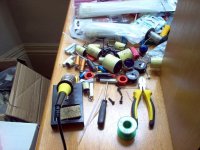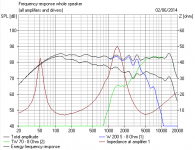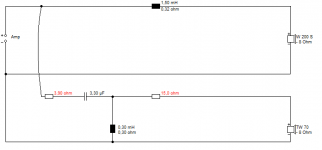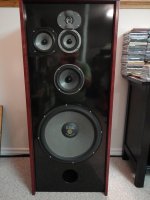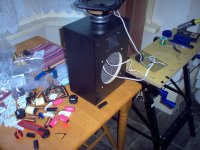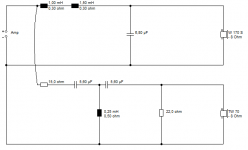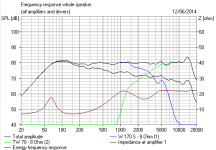BTW, can everyone please explain what they mean, rather than post links and run away giggling. I know it's a BORE writing more than one line, but otherwise these threads go on forever.
The links are pretty much self explaining. Good results need good tools to work with. The last few times I tried to explain anything in threads that you post in, I got my posts deleted so why bother? Seems you don't like anyone else stepping in and helping,
Ok people. I really appreciate everyone's help. I know from experience that programs can be too accurate... One can stare at a graph and try to get perfection. Some times that doesn't happen, especially when a lot of drivers are hand made, so adding more glue to the cone can add more weight, tightening the surround etc, which will change the characteristics of the driver from the specs. So, perfection can't be achieved. In my set up, I am also using the Focal 5W3211B driver. Focal glued rubber feet onto the back of the cone to add weight and reduce resonance. A few years ago, Dr.Crankenstein glued a 1/4" wood piece as a dust cap to their subwoofers to give weight to the cone to help with the lows... lol. So, if it is darn close on a program, it will be and sound incredible. Even some capacitors get a little zippy at the high end. Programs can't take capacitor characteristics into affect either.
So, I ripped apart my original Focal crossover and they used: (tweeter) 3.3uF cap and a 2.4ohm resistor through the positive, the air coil is the size of your thumb mail, but, I don't know the inductance. The (4" mid) has the same size coil, but it has an iron core. I don't know the inductance, but, it has a 1.2ohm resistor through the positive and a 10uF cap.
From what I can see, the values that were given to me are spot on, compared to the original crossover. I did mess up on my side, using a crossover program that was wayyyy, off. I know I will have to attenuate my speakers... that's the easy part, I hope... lol
So, I ripped apart my original Focal crossover and they used: (tweeter) 3.3uF cap and a 2.4ohm resistor through the positive, the air coil is the size of your thumb mail, but, I don't know the inductance. The (4" mid) has the same size coil, but it has an iron core. I don't know the inductance, but, it has a 1.2ohm resistor through the positive and a 10uF cap.
From what I can see, the values that were given to me are spot on, compared to the original crossover. I did mess up on my side, using a crossover program that was wayyyy, off. I know I will have to attenuate my speakers... that's the easy part, I hope... lol
"Programs can't take capacitor characteristics into affect either"
The only two characteristics you need are capacitance and ESR.Some programs allow you to input those. Helps very much if you measure all the components in the crossover as you design it so you know if they meet specs. Caps, coils and resistors can vary enough from published specs to make this worthwhile, then incorporate the measured values into your software along with measured acoustic and impedance of the drivers.
The only two characteristics you need are capacitance and ESR.Some programs allow you to input those. Helps very much if you measure all the components in the crossover as you design it so you know if they meet specs. Caps, coils and resistors can vary enough from published specs to make this worthwhile, then incorporate the measured values into your software along with measured acoustic and impedance of the drivers.
Hmmm......
Someone insisting they've made perfect speakers except
for the most obvious glaring problem. Which suggests if
you've mucked that up the rest of the speaker can't
be too far behind in not being right either, sad but true.
Expensive bits don't help poor design, and are wasted.
That your fishing for some sort of quick fix because
you have spent lots on expensive x/o components
without providing any real technical details is asking
us to be clairvoyants about all your assumptions.
rgds, sreten.
Someone insisting they've made perfect speakers except
for the most obvious glaring problem. Which suggests if
you've mucked that up the rest of the speaker can't
be too far behind in not being right either, sad but true.
Expensive bits don't help poor design, and are wasted.
That your fishing for some sort of quick fix because
you have spent lots on expensive x/o components
without providing any real technical details is asking
us to be clairvoyants about all your assumptions.
rgds, sreten.
Last edited:
That's a good start, coryvirtue. You could really use a good multimeter with an inductance scale next. Pictured below....So, I ripped apart my original Focal crossover and they used: (tweeter) 3.3uF cap and a 2.4ohm resistor through the positive, the air coil is the size of your thumb mail, but, I don't know the inductance. The (4" mid) has the same size coil, but it has an iron core. I don't know the inductance, but, it has a 1.2ohm resistor through the positive and a 10uF cap....
These sort of problems start to make sense when you look at some typical crossovers with similar drivers. Most commercial speakers only have 4 or 5 components so how hard can it be really?
Here's a couple of my own efforts.
An externally hosted image should be here but it was not working when we last tested it.
An externally hosted image should be here but it was not working when we last tested it.
I have a goodish collection of components to play around with too, because we all like to tweak these designs for more of this and less of that. It's quite useful to have a Modelling Program too, if only to make sure that the impedance is decent so you don't stress the amplifier. Try to keep it above 4 ohms. 😎
Visaton provide a load of design files that you can copy to the Projekte folder and get simming something similar straight away.
Boxsim Projektdatenbank Systeme
Enjoy your new hobby!
Attachments
I'm out!
OP is not helping very much (read post#20). 😉
OP is not helping very much (read post#20). 😉
""...without providing any real technical details is asking
us to be clairvoyants about all your assumptions.""
sreten
Oh, I haven't given up on this. The modelling with your FRD and ZMA files was pretty inconclusive, although I could see they just constructed them from the driver SPL plots, but the 8 ohm visaton stock filter seems to work pretty well with 4 ohm bass and 8 ohm tweeter: HW 2/70 NG - 8 Ohm
I think the Focal (Car Speaker?) drive unit must be about 0.6mH Le inductance looking at the ZMA file. But, what's the worst that can happen? You build a filter and it either works, or it's back to the drawing board. But it may be more of a midrange than a midbass.
But it makes a strong case for having a lot of cheap components of different values to try rather than one expensive (Mundorf and Clarity Cap, I'm looking at you!) one. 🙂
I think the Focal (Car Speaker?) drive unit must be about 0.6mH Le inductance looking at the ZMA file. But, what's the worst that can happen? You build a filter and it either works, or it's back to the drawing board. But it may be more of a midrange than a midbass.
But it makes a strong case for having a lot of cheap components of different values to try rather than one expensive (Mundorf and Clarity Cap, I'm looking at you!) one. 🙂
I just finished and the sound is breath taking! The crossover points for the tweeter and 4" was spot on!
Here's my tower of sound:
(1) .75" TLR tweeter, Audiom
(1) 4" Utopia mid, 4w2
(1) 5 1/3" Utopia mid, 5w3211B
(1) 6 1/2" Utopia mid bass, 6w2
(2) 15" Utopia muli-magnet subwoofer in an isobaric chamber box. (push/pull). For tightness........
12 dB per octave crossovers. Combination of Mundorf oil film capacitors and Clarity Caps, Duelund carbon resistors, and a combination of air centered coils.
Here's my tower of sound:
(1) .75" TLR tweeter, Audiom
(1) 4" Utopia mid, 4w2
(1) 5 1/3" Utopia mid, 5w3211B
(1) 6 1/2" Utopia mid bass, 6w2
(2) 15" Utopia muli-magnet subwoofer in an isobaric chamber box. (push/pull). For tightness........
12 dB per octave crossovers. Combination of Mundorf oil film capacitors and Clarity Caps, Duelund carbon resistors, and a combination of air centered coils.
Attachments
Last edited:
A shame you put all that money in parts and didn't bother measuring anything but hey, it's your choice. Enjoy whatever it is you are listening to.
WOW, thanks big Dave! It is a shame you forgot about my posting #5... Focal (JM Labs) themselves told me what components to use... I have their fax right in front of me. The only thing I wanted to up grade is the original FA 110KX crossover used in their original design. The values were hard to read, like the coils, but, hey, maybe the Grand Utopia speakers that JM Labs built are not good enough for your listening experience... 😉
I appreciate your contribution/criticism anyway.
I appreciate your contribution/criticism anyway.
Aw, you'll get used to David, he just likes to pick holes really, and not much else! 😀WOW, thanks big Dave! It is a shame you forgot about my posting #5... Focal (JM Labs) themselves told me what components to use... I have their fax right in front of me. The only thing I wanted to up grade is the original FA 110KX crossover used in their original design. The values were hard to read, like the coils, but, hey, maybe the Grand Utopia speakers that JM Labs built are not good enough for your listening experience... 😉
I appreciate your contribution/criticism anyway.
But I think most of us were a bit unclear what you were trying to do here. I mean, usually a multiple driver speaker has some sort of handoff and crossover phase and impedance consideration between the various drivers duties. It seemed like you were just adding a two way to an existing speaker. But glad it worked.

Yeah I pick "holes" like actually measuring a before and after frequency response so you don't waste time. Sheesh. So have your finished speaker measured some time and let's see how it does hmmmmmm?
Always a work in progress at system7 Labs, mate! And lots of different speakers too. 😀
We don't just gas here, we build stuff. I'm having another go at the hitherto shrieky little MS15 6" paper bass plus TW70 cone tweeter with a bigger BSC coil.
I'm having to improvise a bit, but I'm also looking out for the circuit board mucking the inductance up.
We don't just gas here, we build stuff. I'm having another go at the hitherto shrieky little MS15 6" paper bass plus TW70 cone tweeter with a bigger BSC coil.
I'm having to improvise a bit, but I'm also looking out for the circuit board mucking the inductance up.

Attachments
I think you need to make clear to everyone that you don't measure frequency response at all but use box simulation software and manufacturer's data instead. Any variations from the original specs will not show up in your results.Oh and what do you do about the acoustic plane differences between drivers just guess?
Now why are you calling it's System7 Labs when you earlier said you didn't want to turn your room into a laboratory? Labs as in the dog perhaps?
Now why are you calling it's System7 Labs when you earlier said you didn't want to turn your room into a laboratory? Labs as in the dog perhaps?
Yeah, but David, I take on vaguely specified speakers that no-one else will touch. It's what I do. It works a lot of the time too:
http://www.diyaudio.com/forums/multi-way/225310-system7-steve.html
All 6" drivers are much the same. They all have a roughly 5kHz cone resonance which is where trouble kicks in. Rolloff and damping varies with material. Plastic has most rolloff and damping, then paper. Metal I wouldn't attempt to guess.
Phase is a big subject, but some filters and drivers just work nicely. I follow my nose on that one. It's intuitive.
The Le coil inductance tells you how much it will fight your filtering attempts too. But here's the thing about 6" paper speaker designs, and you can check. They almost all use 2.5mH BSC on second order. 😎
TBH, I don't actually like 6" bass much. The box is too small IMO. But I'll have a go.
http://www.diyaudio.com/forums/multi-way/225310-system7-steve.html
All 6" drivers are much the same. They all have a roughly 5kHz cone resonance which is where trouble kicks in. Rolloff and damping varies with material. Plastic has most rolloff and damping, then paper. Metal I wouldn't attempt to guess.
Phase is a big subject, but some filters and drivers just work nicely. I follow my nose on that one. It's intuitive.
The Le coil inductance tells you how much it will fight your filtering attempts too. But here's the thing about 6" paper speaker designs, and you can check. They almost all use 2.5mH BSC on second order. 😎
TBH, I don't actually like 6" bass much. The box is too small IMO. But I'll have a go.
Last edited:
- Status
- Not open for further replies.
- Home
- Loudspeakers
- Multi-Way
- help! I need passive crossover point suggestions
